Attapulgite Nanorod-Incorporated Polyimide Membrane for Enhanced Gas Separation Performance
Abstract
1. Introduction
2. Materials and Methods
2.1. Materials
2.2. Preparation of Modified ATP
2.3. Preparation of ATP/Polyimide Composite Membrane
2.4. Characterization
2.5. Experimental Method
3. Results and Discussion
3.1. Characterization of PI/ATP Composite Membrane
3.2. Pure Gas Separation Performance
4. Conclusions
Supplementary Materials
Author Contributions
Funding
Conflicts of Interest
References
- Han, Y.; Ho, W.S.W. Polymeric membranes for CO2 separation and capture. J. Membr. Sci 2021, 628, 119244. [Google Scholar] [CrossRef]
- Park, H.B.; Kamcev, J.; Robeson, L.M.; Elimelech, M.; Freeman, B.D. Maximizing the right stuff: The trade-off between membrane permeability and selectivity. Science 2017, 356, eaab0530. [Google Scholar] [CrossRef] [PubMed]
- Kang, S.Y.; Zhang, Z.G.; Wu, L.; Xu, S.; Huo, G.L.; Ma, X.H.; Li, N.W. Synthesis and gas separation properties of polyimide membranes derived from oxygencyclic pseudo-Troger’s base. J. Membr. Sci 2021, 637, 119604. [Google Scholar] [CrossRef]
- Sanaeepur, H.; Amooghin, A.E.; Bandehali, S.; Moghadassi, A.; Matsuur, T.; Bruggen, B.V. Polyimides in membrane gas separation: Monomer’s molecular design and structural engineering. Prog Polym Sci 2019, 91, 80–125. [Google Scholar] [CrossRef]
- Wu, S.S.; Liang, J.C.; Shi, Y.P.; Huang, M.H.; Bi, X.Y.; Wang, Z.D.; Jin, J. Design of interchain hydrogen bond in polyimide membrane for improved gas selectivity and membrane stability. J. Membr. Sci 2021, 618, 118659. [Google Scholar] [CrossRef]
- Robeson, L.M. Correlation of separation factor versus permeability for polymeric membranes. J. Membr. Sci 1991, 62, 165–185. [Google Scholar] [CrossRef]
- Robeson, L.M. The upper bound revisited. J. Membr. Sci 2008, 320, 390–400. [Google Scholar] [CrossRef]
- Chung, T.S.; Jiang, L.Y.; Li, Y.; Kulprathipanja, S. Mixed matrix membranes (MMMs) comprising organic polymers with dispersed inorganic fillers for gas separation. Prog. Polym. Sci. 2007, 32, 483–507. [Google Scholar] [CrossRef]
- Hu, C.C.; Cheng, P.H.; Chou, S.C.; Lai, C.L.; Huang, S.H.; Tsai, H.A.; Hung, W.S.; Lee, K.R. Separation behavior of amorphous amino-modified silica nanoparticle/polyimide mixed matrix membranes for gas separation. J. Membr. Sci 2020, 595, 117542. [Google Scholar] [CrossRef]
- Nezhadmoghadam, E.; Chenar, M.P.; Omidkhah, M.; Nezhadmoghadam, A.; Abedini, R. Aminosilane grafted Matrimid 5218/nano-silica mixed matrix membrane for CO2/light gases separation. Korean J. Chem. Eng. 2018, 35, 526–534. [Google Scholar] [CrossRef]
- Sun, H.X.; Ma, C.; Yuan, B.B.; Wang, T.; Xu, Y.Y.; Xue, Q.Z.; Li, P.; Kong, Y. Cardo polyimides/TiO2 mixed matrix membranes: Synthesis, characterization, and gas separation property improvement. Sep. Purif. Technol. 2014, 122, 367–375. [Google Scholar] [CrossRef]
- Kong, Y.; Du, H.W.; Yang, J.R.; Shi, D.; Wang, Y.F.; Zhang, Y.Y.; Xin, W. Study on polyimide/TiO2 nanocomposite membranes for gas separation. Desalination 2002, 146, 49–55. [Google Scholar] [CrossRef]
- Liu, Y.; Xie, W.; Liang, S.; Li, X.X.; Fan, Y.F.; Luo, S.J. Polyimide/ZIFs mixed matrix membranes with tunable interfacial interaction for efficient gas separation. J. Membr. Sci. 2022, 646, 120240. [Google Scholar] [CrossRef]
- Yong, H.H.; Park, H.C.; Kang, Y.S.; Wona, J.; Kim, W.N. Zeolite-filled polyimide membrane containing 2,4,6-triaminopyrimidine. J. Membr. Sci. 2001, 188, 151–163. [Google Scholar] [CrossRef]
- Castro-Munoz, R.; Fila, V. Progress on Incorporating Zeolites in Matrimid (R) 5218 Mixed Matrix Membranes towards Gas Separation. Membranes 2018, 8, 30. [Google Scholar] [CrossRef] [PubMed]
- Sun, H.X.; Wang, T.; Xu, Y.Y.; Gao, W.; Li, P.; Niu, Q.J. Fabrication of polyimide and functionalized multi-walled carbon nanotubes mixed matrix membranes by in-situ polymerization for CO2 separation. Sep. Purif. Technol. 2017, 177, 327–336. [Google Scholar] [CrossRef]
- Wu, L.G.; Yang, C.H.; Wang, T.; Zhang, X.Y. Enhanced the performance of graphene oxide/polyimide hybrid membrane for CO2 separation by surface modification of graphene oxide using polyethylene glycol. Appl. Surf. Sci. 2018, 440, 1063–1072. [Google Scholar] [CrossRef]
- Huang, R.L.; Lin, Q.T.; Zhong, Q.F.; Zhang, X.F.; Wen, X.Q.; Luo, H.Y. Removal of Cd(II) and Pb(II) from aqueous solution by modified attapulgite clay. Arab. J. Chem. 2020, 13, 4994–5008. [Google Scholar] [CrossRef]
- Fan, Z.R.; Zhou, S.Y.; Mao, H.Y.; Li, M.S.; Xue, A.L.; Zhao, Y.J.; Xing, W.H. A novel ceramic microfiltration membrane fabricated by anthurium and raeanum-like attapulgite nanofibers for high-efficiency oil-in-water emulsions separation. J. Membr. Sci. 2021, 630, 119291. [Google Scholar] [CrossRef]
- Xu, K.; Li, C.W.; Wang, C.S.; Jiang, Y.J.; Liu, Y.; Xie, H.F. Natural and acid-treated attapulgite reinforced soybean oil-based polyurethane/epoxy resin interpenetrating polymer networks. J. Therm. Anal. Calorim. 2019, 137, 1189–1198. [Google Scholar] [CrossRef]
- Xiang, L.; Pan, Y.; Jiang, J.; Chen, Y.; Chen, J.; Zhang, L.X.; Wang, C.Q. Thin poly (ether-block-amide)/attapulgite composite membranes with improved CO2 permeance and selectivity for CO2/N2 and CO2/CH4. Chem. Eng. Sci. 2017, 160, 236–244. [Google Scholar] [CrossRef]
- Xiang, L.; Pan, Y.C.; Zeng, G.F.; Jiang, J.L.; Chen, J.; Wang, C.Q. Preparation of poly (ether-block-amide)/attapulgite mixed matrix membranes for CO2/N2 separation. J. Membrane. Sci. 2016, 500, 66–75. [Google Scholar] [CrossRef]
- Ahmad, S.; Lian, S.H.; Tan, Y.; Li, R.; Zhao, Q.; Song, C.F.; Liu, Q.L.; Lu, S.J. Solvent influence on the textural properties and CO2/N2 separation performance of novel Pebax-1657/attapulgite mixed matrix membranes. J. Enviro. Chem. Eng. 2021, 9, 105806. [Google Scholar] [CrossRef]
- Wang, F.; Zhang, B.; Liu, S.S.; Wu, Y.H.; Wang, T.H.; Qiu, J.S. Investigation of the attapulgite hybrid carbon molecular sieving membranes for permanent gas separation. Chem. Eng. Res. Des. 2019, 151, 146–156. [Google Scholar] [CrossRef]
- Xu, J.L.; Ren, S.B.; Kang, C.H.; Cui, F.D.; Li, C.S.; Fan, J.L. Study on the ball milling modification of attapulgite. Mate Res. Express 2020, 7, 115006. [Google Scholar] [CrossRef]
- Ma, X.H.; Zhu, Z.Y.; Shi, W.X.; Ji, W.H.; Li, J.X.; Wang, Y.G.; Pinnau, I.G. Unprecedented gas separation performance of a difluoro-functionalized triptycene-based ladder PIM membrane at low temperature. J. Mater. Chem. A 2021, 9, 5404–5414. [Google Scholar] [CrossRef]
- Zhang, S.Y.; Wang, Z.; Cai, M.W.; Lu, X.C.; Fan, T.J.; Wang, R.B.; Liu, Y.D.; Min, Y.G. Attapulgite nanorods incorporated MXene lamellar membranes for enhanced decontamination of dye wastewater. Nanomaterials 2022, 12, 3094. [Google Scholar] [CrossRef]
- Liu, S.K.; Zhang, Z.P.; Qi, Y.H. Effect of emulsifier on the structure and properties of waterborne silicone antifouling coating. Coating 2020, 10, 168. [Google Scholar] [CrossRef]
- Radmanesh, F.; Pilz, M.; Ansaloni, L.; Peters, T.A.; Louradou, E.; Veen, H.V.; Høvik, D.; Hempenius, M.A.; Benes, N.E. Comparing amine- and ammonium functionalized silsesquioxanes for large scale synthesis of hybrid polyimide high-temperature gas separation membranes. J. Membr. Sci 2021, 637, 119524. [Google Scholar] [CrossRef]
- Shao, L.; Chung, T.S.; Goh, S.H.; Pramoda, K.P. Transport properties of cross-linked polyimide membranes induced by different generations of diaminobutane (DAB) dendrimers. J. Membr. Sci 2004, 238, 153–163. [Google Scholar] [CrossRef]
- Yang, C.Y.; Xu, W.X.; Nan, Y.; Wang, Y.G.; Hu, Y.X.; Gao, C.J.; Chen, X.L. Fabrication and characterization of a high performance polyimide ultrafiltration membrane for dye removal. J. Colloid. Interf. Sci. 2020, 562, 589–597. [Google Scholar] [CrossRef] [PubMed]
- Jia, W.; Zhou, L.R.; Jiang, M.; Du, J.; Zhang, M.J.; Han, E.L.; Niu, H.Q.; Wu, D.Z. Fabrication of polyimide/graphene nanosheet composite fibers via microwave-assisted imidization strategy. RSC. Adv. 2021, 11, 32647–32653. [Google Scholar] [CrossRef] [PubMed]
- Wang, C.Y.; Zeng, W.J.; Jiang, T.T.; Chen, X.; Zhang, X.L. Incorporating attapulgite nanorods into graphene oxide nanofiltration membranes for efficient dyes wastewater treatment. Sep. Purif. Technol. 2019, 214, 21–30. [Google Scholar] [CrossRef]
- Li, J.; Xu, C.C.; Zhang, Y.; Wang, R.F.; Zha, F.; She, H. Robust superhydrophobic attapulgite coated polyurethane sponge for efficient immiscible oil/water mixture and emulsion separation. J. Mater. Chem. A 2016, 4, 15546–15553. [Google Scholar] [CrossRef]
- Zhang, Y.; Jing, Z.; Chu, H.; Zhou, X.F.; Wei, Y. Effect of modified attapulgite addition on the performance of a PVDF ultrafiltration membrane. Desalination 2014, 344, 71–78. [Google Scholar] [CrossRef]
- Ahn, J.Y.; Chung, W.J.; Pinnau, I.; Guiver, M.D. Poly sulfone/silica nanoparticle mixed-matrix membranes for gas separation. J. Membr. Sci. 2008, 314, 123–133. [Google Scholar] [CrossRef]
- An, L.; Pan, Y.Z.; Shen, X.W.; Lu, H.B.; Yang, Y.L. Rod-like attapulgite/polyimide nanocomposites with simultaneously improved strength, toughness, thermal stability and related mechanisms. J. Mater. Chem. 2008, 18, 4928–4941. [Google Scholar] [CrossRef]
- Zhang, Y.; Shen, J.; Li, Q.; Xu, Z.S.; Yeung KW, K.; Yi, C.F.; Zhang, Q.Y. Development and Characterization of Co-Polyimide/Attapulgite Nanocomposites with Highly Enhanced Thermal and Mechanical Properties. Polym. Composite 2014, 35, 86–96. [Google Scholar] [CrossRef]
- Wang, Y.Q.; Feng, Y.; Jiang, J.L.; Yao, J.F. Designing of Recyclable Attapulgite for Wastewater Treatments: A Review. ACS Sustain. Chem. Eng. 2019, 7, 1855–1869. [Google Scholar] [CrossRef]
- Zhu, J.D.; Zhao, F.X.; Xiong, R.J.; Peng, T.P.; Ma, Y.Y.; Hu, J.; Xie, L. Thermal insulation and flame retardancy of attapulgite reinforced gelatin-based composite aerogel with enhanced strength properties. Compos. Part. A-Appl. S 2020, 138, 106040. [Google Scholar] [CrossRef]
- Moghadam, F.; Omidkhah, M.R.; Vasheghani-Farahani, E.; Pedram, M.Z.; Dorosti, F. The effect of TiO2 nanoparticles on gas transport properties of Matrimid5218-based mixed matrix membranes. Sep. Purif. Technol. 2011, 77, 128–136. [Google Scholar] [CrossRef]
- Moore, T.T.; Koros, W.J. Non-ideal effects in organic-inorganic materials for gas separation membranes. J. Mol. Struct. 2005, 739, 87–98. [Google Scholar] [CrossRef]
- Jusoh, N.; Yeong, Y.F.; Lau, K.K.; Shariff, A.M. Enhanced gas separation performance using mixed matrix membranes containing zeolite T and 6FDA-durene polyimide. J. Membr. Sci. 2017, 525, 175–186. [Google Scholar] [CrossRef]
- Ahmad, J.; Deshmukh, K.; Hagg, M.B. Influence of TiO2 on the Chemical, Mechanical, and Gas Separation Properties of Polyvinyl Alcohol-Titanium Dioxide (PVA-TiO2) Nanocomposite Membranes. Int. J. Polym. Anal. Ch. 2013, 18, 287–296. [Google Scholar] [CrossRef]
- Moghadassi, A.R.; Rajabi, Z.; Hosseini, S.M.; Mohammadi, M. Preparation and Characterization of Polycarbonate-Blend-Raw/Functionalized Multi-Walled Carbon Nano Tubes Mixed Matrix Membrane for CO2 Separation. Sep. Purif. Technol. 2013, 48, 1261–1271. [Google Scholar]
- Kim, J.H.; Lee, Y.M. Gas permeation properties of poly(amide-6-b-ethylene oxide)-silica hybrid membranes. J. Membr. Sci. 2001, 193, 209–225. [Google Scholar] [CrossRef]
- Zhang, Y.; Musselman, I.H.; Ferraris, J.P.; Balkus, K.J., Jr. Gas permeability properties of Matrimid® membranes containing the metal-organic framework Cu–BPY–HFS. J. Membr. Sci. 2008, 313, 170–181. [Google Scholar] [CrossRef]
- Murali, R.S.; Sridhar, S.; Sankarshana, T.; Ravikumar, Y.V.L. Gas Permeation Behavior of Pebax-1657 Nanocomposite Membrane Incorporated with Multiwalled Carbon Nanotubes. Ind. Eng. Chem. Res. 2010, 49, 6530–6538. [Google Scholar] [CrossRef]
- Li, P.; Chung, T.S.; Paul, D.R. Gas sorption and permeation in PIM-1. J. Membr. Sci. 2013, 432, 50–57. [Google Scholar] [CrossRef]
- Wang, R.; Cao, C.; Chung, T.S. A critical review on diffusivity and the characterization of diffusivity of 6FDA-6FpDA polyimide membranes for gas separation. J. Membr. Sci. 2002, 198, 259–271. [Google Scholar] [CrossRef]
- Zhang, M.L.; Deng, L.M.; Xiang, D.X.; Cao, B.; Hosseini, S.S.; Li, P. Approaches to Suppress CO2-Induced Plasticization of Polyimide Membranes in Gas Separation Applications. Processes 2019, 7, 51. [Google Scholar] [CrossRef]
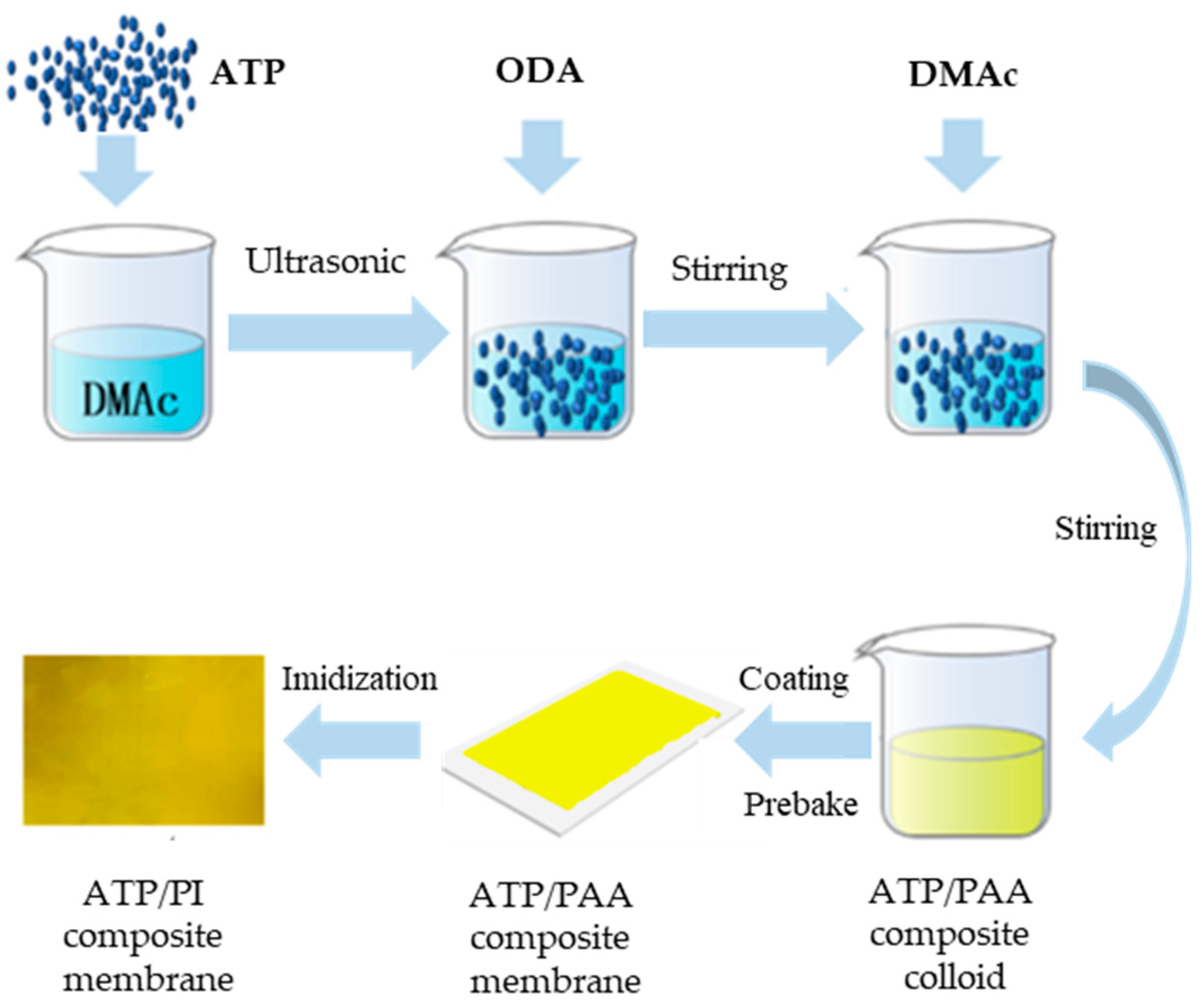
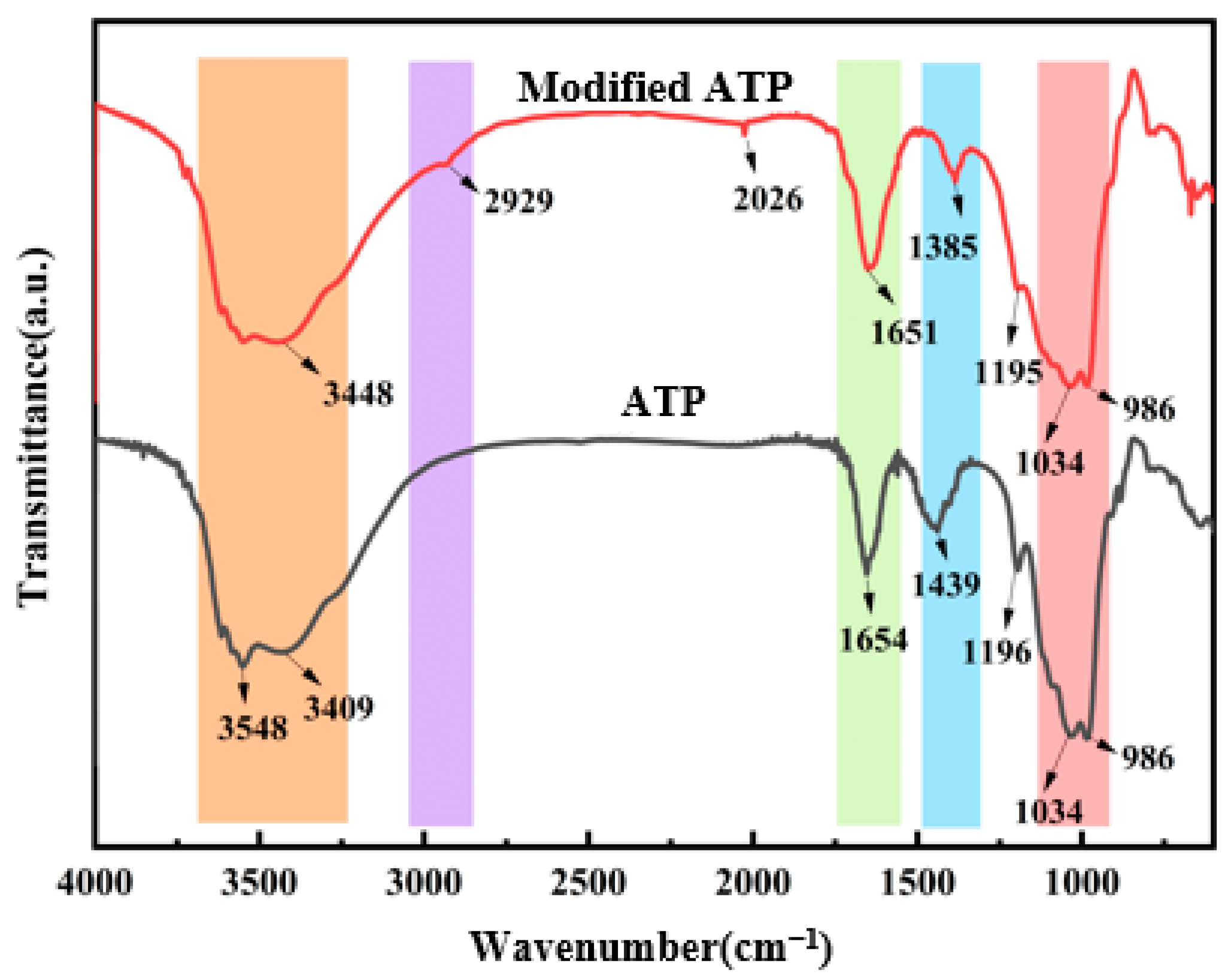
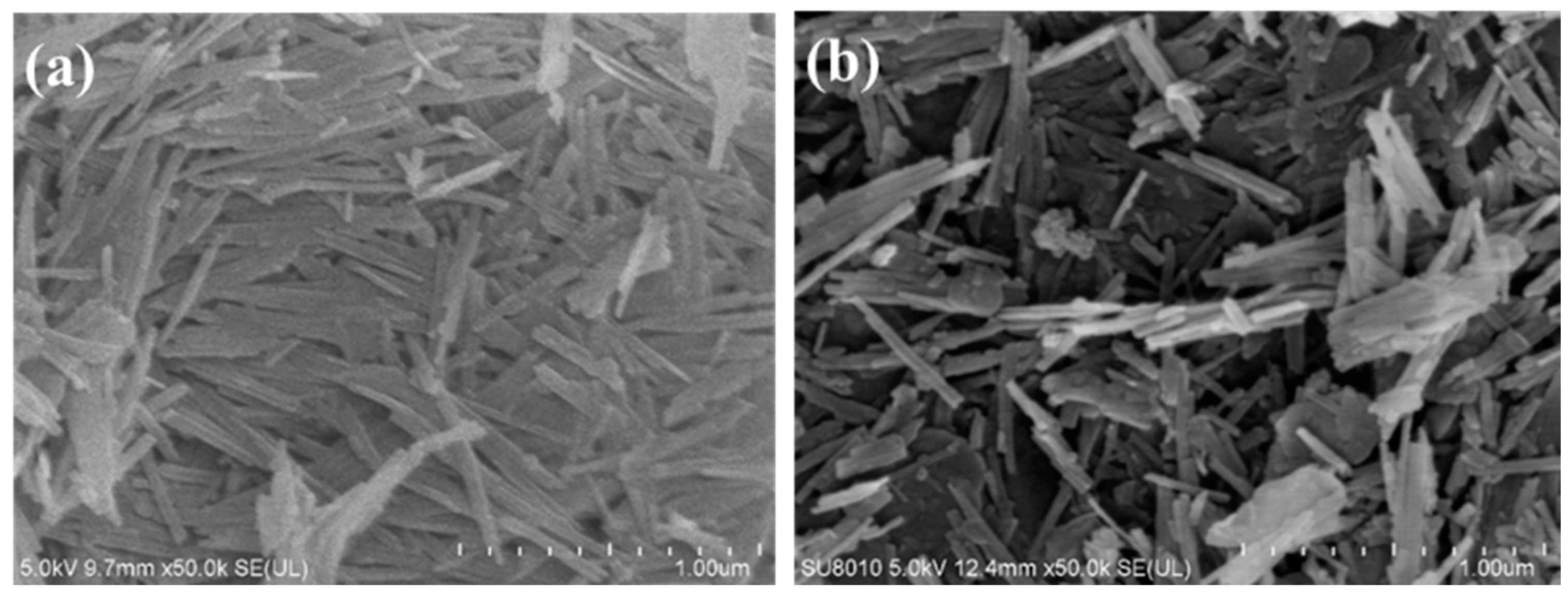


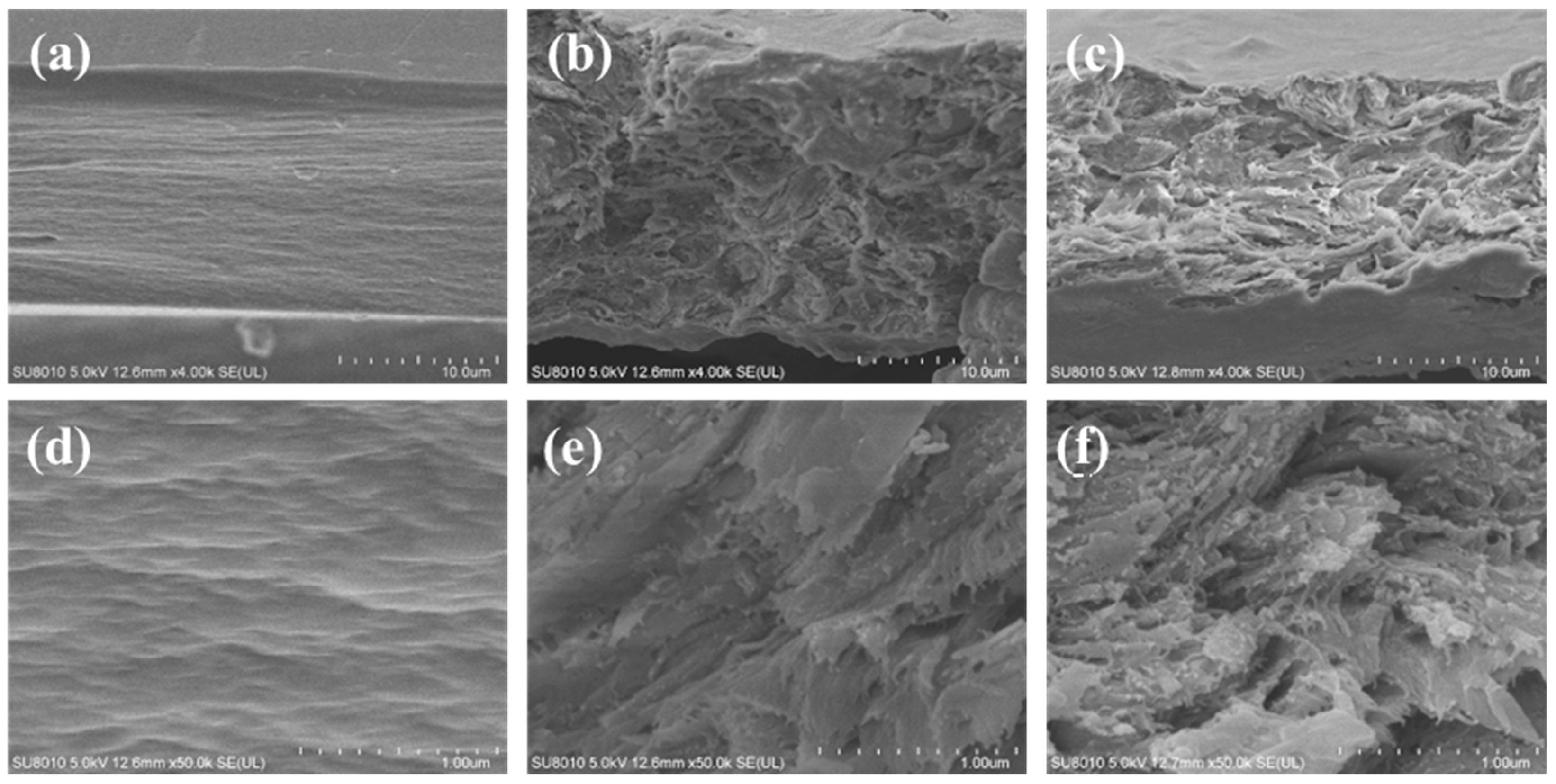
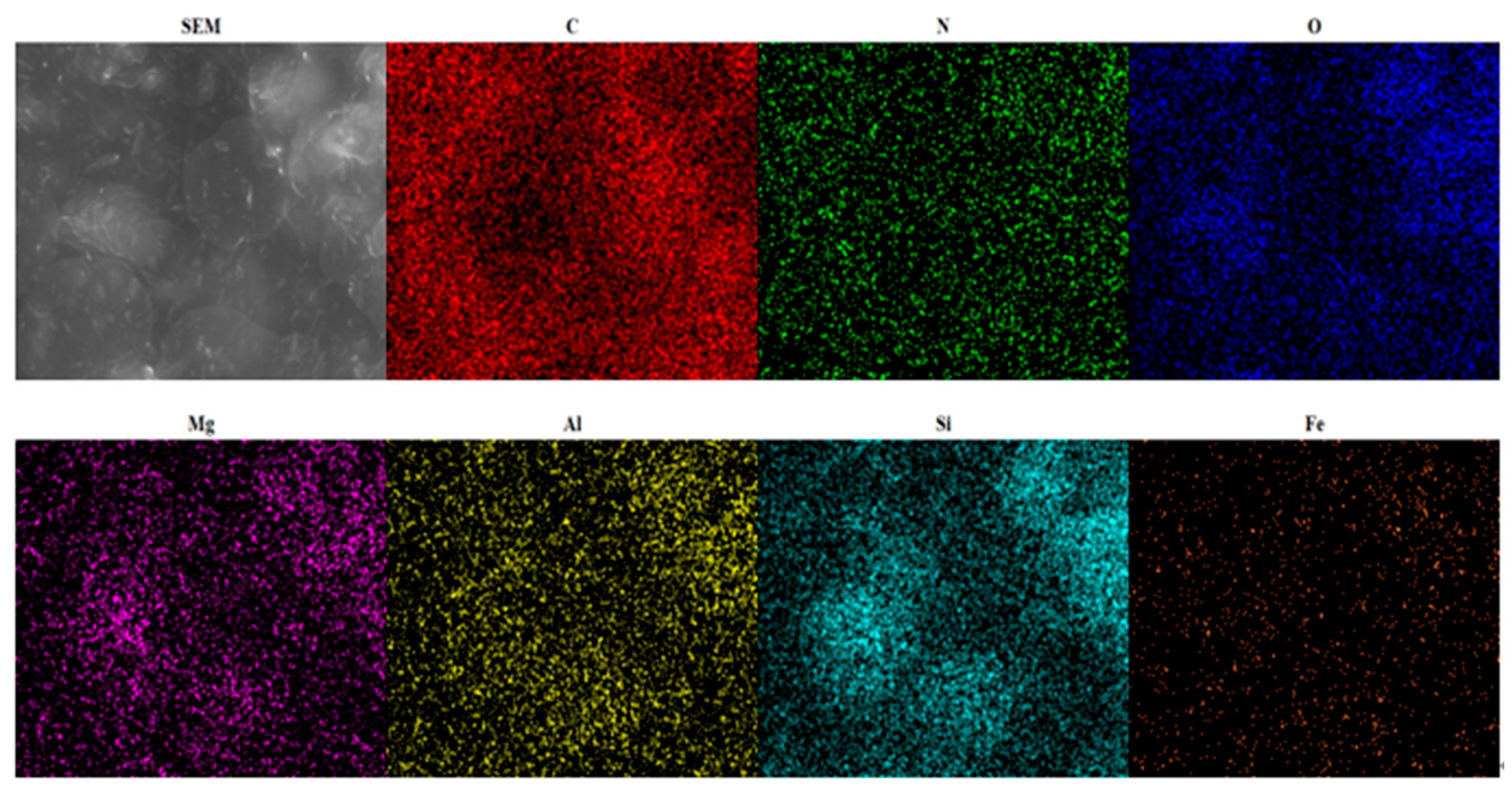
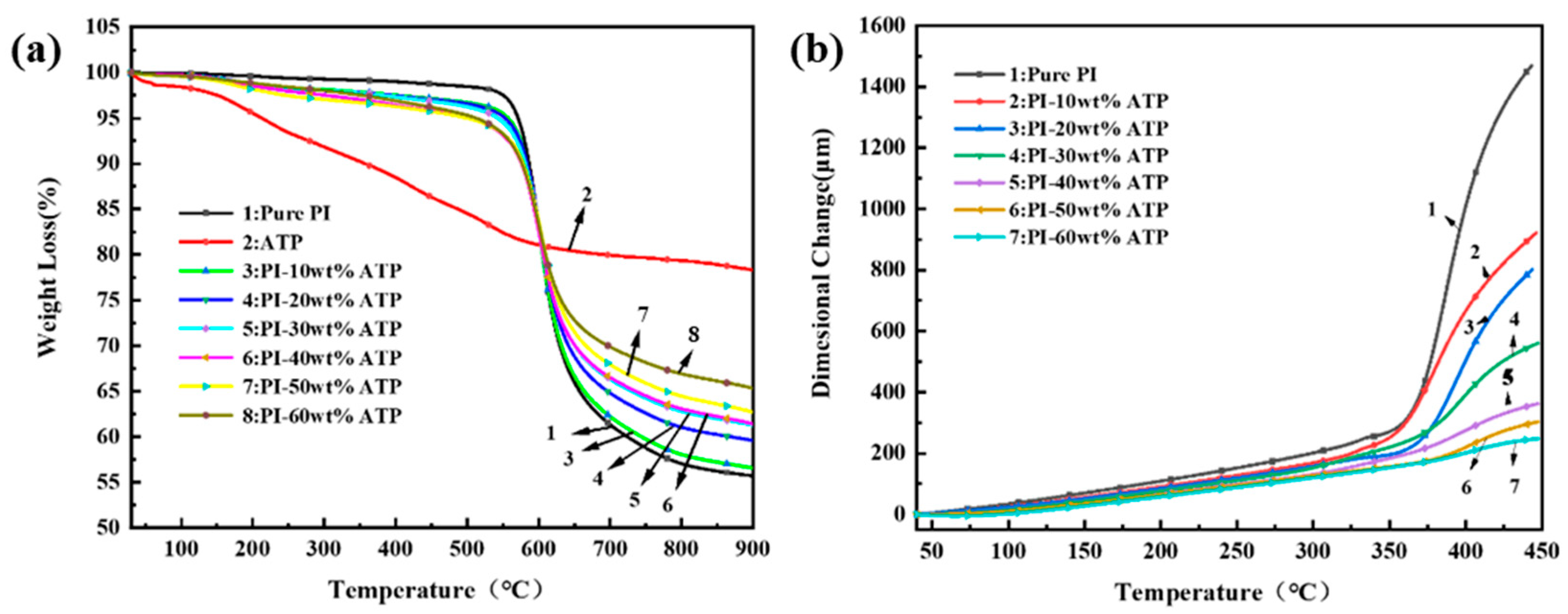

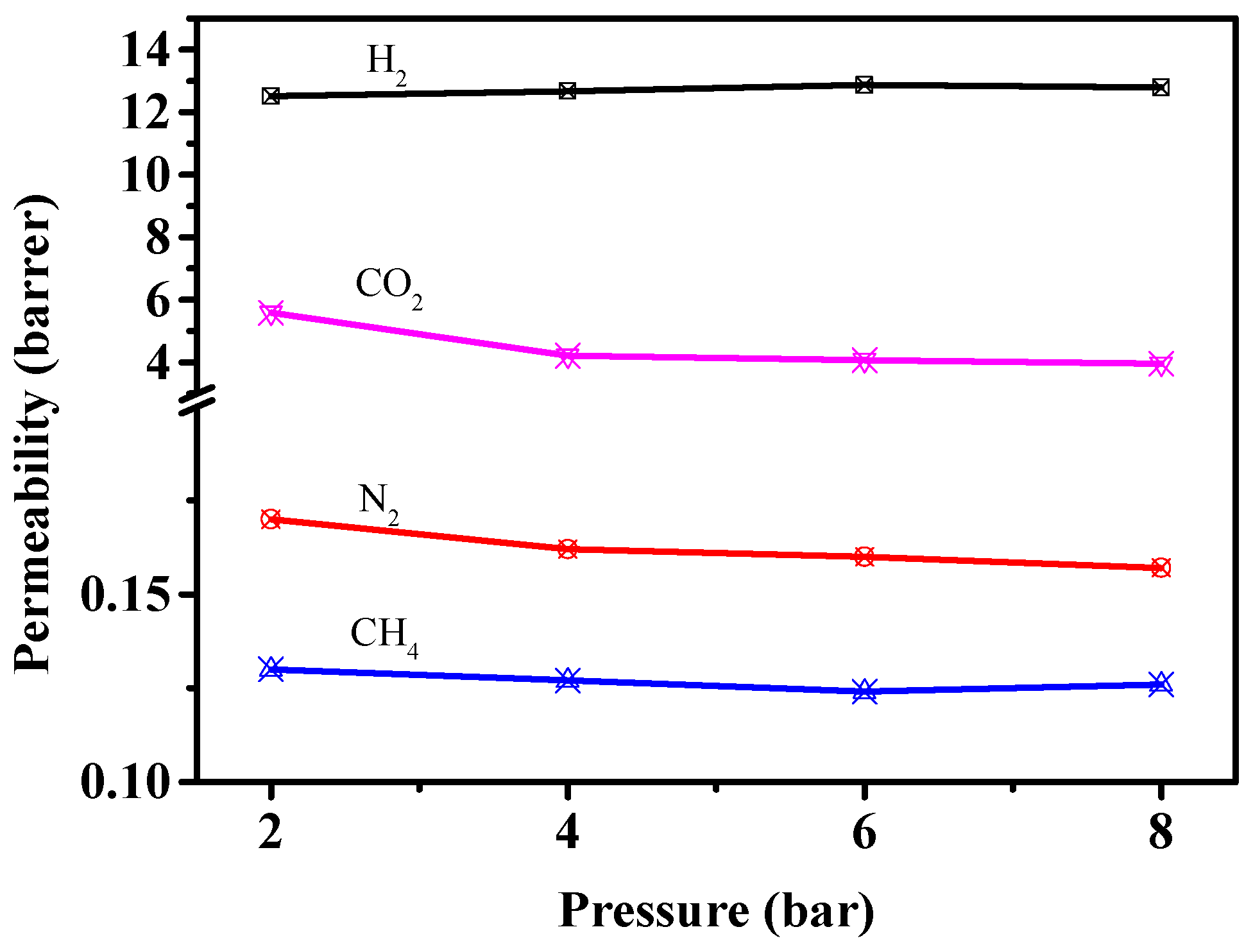
| Membrane | CO2/CH4 | O2/N2 | H2 /CH4 | |||
|---|---|---|---|---|---|---|
| Selectivity | Segregation Index | Selectivity | Segregation Index | Selectivity | Segregation Index | |
| Pure PI | 46.00 | 1.84 | 7.00 | 0.35 | 130.25 | 5.21 |
| PI-10 wt% ATP | 47.83 | 2.87 | 6.50 | 0.52 | 113.83 | 6.83 |
| PI-20 wt% ATP | 46.25 | 3.7 | 6.00 | 0.66 | 113.63 | 9.09 |
| PI-30 wt% ATP | 47.75 | 3.82 | 6.46 | 0.71 | 120.63 | 9.65 |
| PI-40 wt% ATP | 46.44 | 4.18 | 6.50 | 0.78 | 120.22 | 10.82 |
| PI-50 wt% ATP | 46.40 | 4.64 | 6.46 | 0.84 | 118.20 | 11.82 |
| PI-60 wt% ATP | 43.00 | 5.59 | 5.88 | 1 | 96.23 | 12.51 |
| Membrane | Permeability (Barrer) | Selectivity | Ref | |||
|---|---|---|---|---|---|---|
| H2 | CO2 | H2/CH4 | CO2/CH4 | O2/N2 | ||
| PI-0.2 wt% TAP | 0.194 | 87 | [14] | |||
| PSF-0.2 wt% SiO2 | 19.7 | 18 | 4.5 | [36] | ||
| PVA-40 wt% TiO2 | 1.84 | [44] | ||||
| PC-10 wt% MWNTs | 12.79 | 30.45 | [45] | |||
| Pebax-19 wt% SiO2 | 3.2 | [46] | ||||
| Matrimid®-10 wt% Cu | 16.91 | 69.15 | [47] | |||
| Pebax-2 wt% MWNT | 2.1 | [48] | ||||
| PI-50 wt% ATP | 11.82 | 4.64 | 118.20 | 46.40 | 6.46 | this work |
| PI-60 wt% ATP | 12.51 | 5.59 | 96.23 | 43.00 | 5.88 | this work |
Publisher’s Note: MDPI stays neutral with regard to jurisdictional claims in published maps and institutional affiliations. |
© 2022 by the authors. Licensee MDPI, Basel, Switzerland. This article is an open access article distributed under the terms and conditions of the Creative Commons Attribution (CC BY) license (https://creativecommons.org/licenses/by/4.0/).
Share and Cite
Zhang, S.; Lu, X.; Cai, M.; Wang, Z.; Han, Z.; Chen, Z.; Liu, R.; Li, K.; Min, Y. Attapulgite Nanorod-Incorporated Polyimide Membrane for Enhanced Gas Separation Performance. Polymers 2022, 14, 5391. https://doi.org/10.3390/polym14245391
Zhang S, Lu X, Cai M, Wang Z, Han Z, Chen Z, Liu R, Li K, Min Y. Attapulgite Nanorod-Incorporated Polyimide Membrane for Enhanced Gas Separation Performance. Polymers. 2022; 14(24):5391. https://doi.org/10.3390/polym14245391
Chicago/Turabian StyleZhang, Shiyang, Xiaochuang Lu, Mingwei Cai, Zhi Wang, Zhenjing Han, Zhiyin Chen, Rongtao Liu, Kaixin Li, and Yonggang Min. 2022. "Attapulgite Nanorod-Incorporated Polyimide Membrane for Enhanced Gas Separation Performance" Polymers 14, no. 24: 5391. https://doi.org/10.3390/polym14245391
APA StyleZhang, S., Lu, X., Cai, M., Wang, Z., Han, Z., Chen, Z., Liu, R., Li, K., & Min, Y. (2022). Attapulgite Nanorod-Incorporated Polyimide Membrane for Enhanced Gas Separation Performance. Polymers, 14(24), 5391. https://doi.org/10.3390/polym14245391





